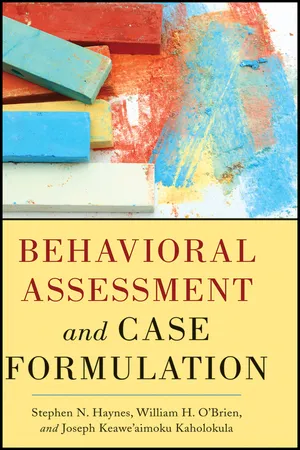Psychology
Self-Report Design
Self-report design refers to a research method in which participants provide information about their thoughts, feelings, or behaviors. This can be done through questionnaires, interviews, or surveys. Self-report designs are commonly used in psychology to gather subjective data directly from individuals, allowing researchers to explore their experiences and perspectives.
Written by Perlego with AI-assistance
Related key terms
Related key terms
1 of 4
Related key terms
1 of 3
3 Key excerpts on "Self-Report Design"
- eBook - ePub
Research Methods in Clinical Psychology
An Introduction for Students and Practitioners
- Chris Barker, Nancy Pistrang, Robert Elliott(Authors)
- 2015(Publication Date)
- Wiley-Blackwell(Publisher)
6 Self-Report MethodsKEY POINTS IN THIS CHAPTER
- Self-report methods, such as interviews and questionnaires, ask the person for information directly.
- Their advantage is that they give you the person’s own perspective; their disadvantage is that there are potential validity problems (e.g., people may deceive themselves or others).
- The main qualitative self-report approach is the semi-structured interview.
- Qualitative interviewing is a distinct skill, related to but different from clinical interviewing.
- The main quantitative self-report approach is the written questionnaire, but structured interviews and internet surveys are also used.
- There are several principles to follow in constructing quantitative self-report instruments.
- Response sets, such as acquiescence and social desirability, refer to tendencies to respond to items independently of their content. They need to be taken into account when designing and interpreting self-report measures.
When you want to know something about a person, the most natural thing is to ask. Research methods that take the approach of asking the person directly are known as self-report methods, and mainly take the form of interviews, questionnaires, and rating scales. They are the most commonly used type of measure in the social sciences in general and in clinical psychology in particular.For example, suppose that you have set up a new counseling service for adolescents and want to evaluate its effectiveness. You ask the service users to rate the severity of their problems before and after counseling and how satisfied they are, using standardized instruments. You also use a semi-structured interview to assess the adolescents’ overall experience of the service, including what they feel they has changed, what they found helpful, and any specific criticisms they had of it. Client satisfaction studies and clinical effectiveness studies - eBook - ePub
Behavioral Cybersecurity
Applications of Personality Psychology and Computer Science
- Wayne Patterson, Cynthia E. Winston-Proctor(Authors)
- 2019(Publication Date)
- CRC Press(Publisher)
Within the field of behavioral science, there are a range of research questions that researchers pursue and consider in designing research to understand human behavior. There is a research process in behavioral science that engages multiple types of considerations about the nature of what counts as knowledge (epistemology), the general approach for carrying out the research (methodology), and procedures for collecting and analyzing data (methods). The theoretical diversity in conceptualization of human personality discussed in previous chapters is matched by the methodological variation used to study personality.The most common research designs used to explore personality are correlational, experimental, and narrative designs. Within personality psychology, there are different levels of analysis that correspond to trying to understanding how a person is like all others (i.e., human nature), like some others (i.e., individual differences), and like no others (i.e., human uniqueness) (Kluckhohn and Murray, 1953). The purpose of this chapter is to describe methods of inquiry used in personality psychology to advance the argument that personality research methods of inquiry and personality tests used to assess personality can be used to advance the science of cybersecurity by applying and generating personality research designs, questions, and methods to better understand, protect, and defend information and systems in cybersecurity situations.17.1Research Designs Used in Personality PsychologyWithin behavioral science, research design is the general approach to inquiry about a phenomenon. Crotty (1998) in his book, The Foundations of Social Research: Meaning and Perspective in the Research Process , described a basic approach to research design in terms of four key questions that are pertinent for design: (1) What methods do we propose? (2) What methodology governs our choice and use of methods? (3) What theoretical perspective lies behind the methodology in question? (4) What epistemology informs this theoretical perspective? Crotty (1998) defined the key concepts within these questions as follows.17.1.1The Research Process Methodologies (p. 7): Design strategies of inquiry (plan of action that shapes our choice and use of particular methods and links them to a desired outcome) Methods (p. 6): Procedures and techniques to gather and analyze data (the specifics and details of carrying out our research activities/design/plan of action) - eBook - ePub
- Stephen N. Haynes, William O'Brien, Joseph Kaholokula(Authors)
- 2011(Publication Date)
- Wiley(Publisher)
Chapter 8 Self-Report Methods in Behavioral Assessment OVERVIEW OF SELF-REPORT BEHAVIORAL ASSESSMENT METHODS AND STRATEGIESThe case of Mrs. Anderson that we describe in Chapter 7 illustrates how behavioral assessment methods and strategies are consistent with the principles of the behavioral assessment paradigm and the functional analysis. Behavioral assessment emphasizes the use of minimally inferential and clearly defined measures of behavior and related events that have well-developed psychometric properties, are sensitive to change, and appropriate for the characteristics of an individual client and the assessment context. Additionally, the behavioral assessment paradigm encourages the measurement of multiple response modes, dimensions, and attributes of a behavior, using a level of specificity that is most applicable to the problem behavior under investigation and the goals of the assessment. There is an assumption that the most accurate and valid information will be obtained when assessments include multiple informants, multiple measurement methods, and data collection in multiple settings.In this chapter, we discuss a subset of behavioral assessment methods: those that rely on self-report. There are several types of self-report methods, including behavioral interviews, questionnaires, and self-monitoring using a daily log or an electronic diary. We refer the reader to Hersen (2006a, 2006b), Fernández-Ballesteros (2004), and Fernández-Ballesteros and Botella (2008) for an elaboration on the self-report methods discussed in this chapter.Self-report assessment methods are used across all psychological assessment paradigms because they can easily be administrated in most settings, are flexible in their clinical applicability and utility, and are relatively cost- and time-efficient compared to direct observational and psychophysiological methods of assessment. Additionally, self-report methods are the only way that a client’s cognitive and emotional experiences and subjective appraisal of causal relations can be ascertained. Although there are self-report assessment methods that assess personality traits and unconscious processes, behavioral assessment focuses on more specific and measurable behaviors and events that allow for the specification of a client’s behavior problems and of relevant functional relations.
Index pages curate the most relevant extracts from our library of academic textbooks. They’ve been created using an in-house natural language model (NLM), each adding context and meaning to key research topics.
Explore more topic indexes
Explore more topic indexes
1 of 6
Explore more topic indexes
1 of 4


